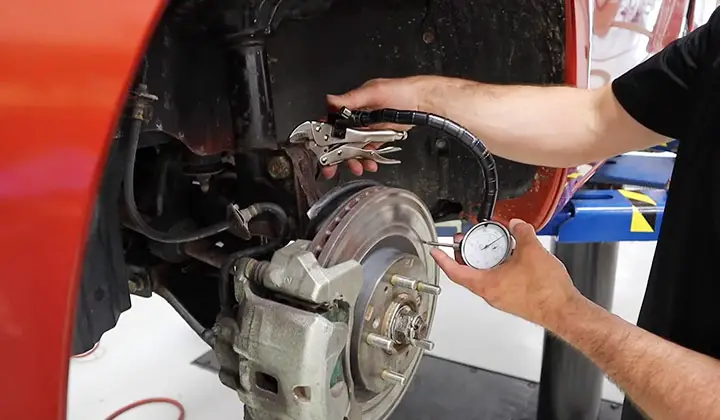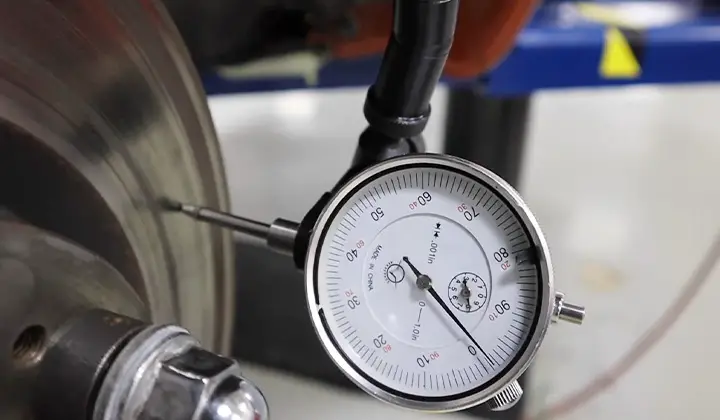Rotor runout is the distance between the outer edge of a rotor and its hub. This measurement can be used to diagnose problems with engine performance, such as worn or damaged rotors.
Rotor runout can be caused by a number of factors including incorrect assembly, worn or damaged parts, and metal-to-metal contact.
If this issue is not corrected, it may lead to decreased engine performance and even failure.
Contents
- 1 What Is Rotor Runout
- 1.1 Side to side movement
- 1.2 Gets excessive
- 1.3 Pad and rotor wear
- 1.4 Vehicle Vibrates
- 1.5 Pulsation
- 1.6 Damage to Steering System
- 1.7 Increased Fuel Consumption & Emissions
- 1.8 Causes of Rotor Runout
- 1.9 Worn or Defective Rotor
- 1.10 Faulty Ignition System
- 1.11 Damaged Crankshaft Main Bearings
- 1.12 Damaged Connecting Rods
- 2 How to Check a Rotor Runout
- 3 FAQs
- 4 Final Words
What Is Rotor Runout
Rotor runout is a condition where the rotor on an engine does not spin as it should. This can cause problems with the engine, including missed or decreased fuel economy and increased emissions.

To check for rotor runout, your mechanic will use a diagnostic tool called an oscilloscope. The below issues tell that you have the runout rotors:
Side to side movement
If the rotor runout gets excessive, it can cause your car to shake and vibrate in different directions at certain points on the steering wheel. This issue is usually caused by pad and rotor wear.
Over time, these parts of the rotor will start to move from side to side instead of rotating smoothly.
Gets excessive
When rotors are running out of roundness, they may start moving excessively from side to side which can lead to vibration and shaking in your car’s steering wheel.
Pad and rotor wear
Rotor runout is often associated with worn pads or rotors – both of which reduce its ability to frictionally grip the disk surface, causing it to spin freely instead of staying stationary while turning the wheels.
If you notice that the rotor on your car’s engine is running out of oil, this could be a sign of rotational wear. Rotor runout causes the engine to lose power and can lead to serious problems down the road.
To prevent this from happening, it’s important to keep your car’s rotor in good condition by regularly replacing or maintaining it.
Vehicle Vibrates
If there is vibration in the steering wheel, it may be a sign that your rotor runout is increasing. Rotor runout is the distance between the outer edge of each rotor and the center hub of your steering column.
This can lead to vibration in your vehicle’s steering wheel.
Pulsation
Pulsation can also be caused by rotor runout. When there is too much space between the rotors and the hub, vibrations will start to build up inside your car frame and dashboard, which will result in pulsating movements or jolts throughout your entire vehicle.
Damage to Steering System
When excessive amounts of vibration reach certain parts of your car’s steering system, it can cause wear and tear on these components over time, eventually leading to damage or even failure altogether.
Increased Fuel Consumption & Emissions
If you have significant rotor runout, it could also contribute to increased fuel consumption and emissions levels within your engine bay – two issues that are often closely linked together.
Causes of Rotor Runout
Rotor runout is a condition where the rotor on an engine stops spinning. This can cause problems with the engine’s performance, including decreased fuel efficiency and increased emissions.
The main causes of rotor runout are wear and tear, faulty parts or maintenance procedures, and using the wrong type of oil.
Worn or Defective Rotor
A worn or defective rotor can cause an increase in engine noise and decreased fuel efficiency. The rotor is the component of the engine that helps to turn the pistons and generate power. If it’s damaged, faulty fuel injection will occur and this may result in reduced performance, increased emissions, and a loss of sound during acceleration.
Faulty Ignition System
If there is a problem with your ignition system, it could lead to a failed rotor due to incorrect timing or wear on the spark plugs caused by over-torquing of bolts.
This can also happen if the corrosion has formed on any electrical parts within the ignition system including coils, capacitors, relays etcetera.
Damaged Crankshaft Main Bearings
A damaged crankshaft main bearing can also cause a failure in your rotors as they rely on accurate movement from the crankshaft main bearings for proper assembly and function of other critical engine components such as Pistons & Cams.
Damaged Connecting Rods
A broken connecting rod will either shear off one end or deform so much that it causes excessive wear on other major rotating components like camshafts & journals. Both these failures will eventually lead to premature failure of your rotors.
How to Check a Rotor Runout
If you’re having trouble starting your car, the first thing to check is the rotor runout. This is a small metal part on the bottom of your engine that helps turn the gears.

If it’s not working properly, this can cause problems with starting and running. You can check rotor runout by removing the spark plugs and checking for worn or missing teeth on the gear wheel.
Rotor runout is the distance between the shaft centerline and the rotor blade centerline. There are a few ways to check the rotor runout.
It can be checked by checking if there is a gap between the shaft and rotor, or by measuring from one side of the shaft to another.
Proper Tools
In order to properly check rotor runout, you will need the right tools. A rotary caliper is a must-have tool for checking rotor runout on your vehicle.
This device can be used to measure the distance between the rotor and stator ring. You should also have an indicator gauge and a set of hex keys in order to remove and replace your spark plugs.
Before starting any engine repair work, it is important that you understand how to properly check rotor runout using a rotary caliper. The following procedure will show you how:
Park your car in a safe location
Park your car in a safe location with plenty of room around it. Disable the ignition system by removing the key from the Ignition switch and disconnecting both battery cables (leave one cable connected if replacing spark plugs). Remove front wheel covers.
Disconnect all electrical connectors (including negative battery cable), ABS sensors, traction/differential control unit wiring harnesses as well as air conditioner refrigerant line access plug at passenger side frontal quarter panel behind grille; note these locations before breaking off connections temporarily “just in case”.
Loosen upper mounting bolts that secure cover assembly onto crankshaft pulley.
Carefully lower cover assembly so that the top surface of the crankshaft pulley points directly over the face of the metric-type spindle on the main bearing shaft. Align holes in the cover plate with corresponding notches on the spindle.
Remove the spark plugs
The first step is to remove the spark plugs, which will give you a good view of the rotor runout. Make sure to use a Spark Plug Wrench so that you don’t damage your engine.
Check for Cylinder Head Scratches
Next, check for any scratches on the cylinder head using a Sharpie or other marker. If there are any significant scratches, this may indicate that the rotor is not running true and needs to be replaced.
Measure Rotor Runout with calipers
If all else fails and you still suspect that your rotor is out of round, it can be measured using some type of caliper device.
Just make sure that everything is properly secured before taking measurements in order to avoid damaging anything important inside your engine bay.
If your car has a problem with the rotors, you may need to have them replaced.
To check if this is the case, first, remove the wheel and brake pads. If there’s any sign of rust on or around the rotor hub, it means that the rotor runout is too high and needs to be fixed.
FAQs
What Is Acceptable Rotor Runout?
Rotor runout is a term that refers to the distance of a rotor blade from the hub, measured in degrees.
What Causes Brake Disc Run-out?
Brake disc run-out is a condition where the brake pads wear down to a point where they no longer have enough material to stop the car.
Why Does It Sound Like My Rotors Are Rubbing?
The sound of engine rubbing is a common problem that many people have. The sound comes from the engine’s rotating parts rubbing together.
Final Words
Rotor runout is an indication that your rotors have gone bad. It is an issue with the manufacturing of electric motors and can cause problems in your vehicle. When you have rotor runout, it means that there are irregularities or gaps in the metal finish on the motor itself.
If you experience any issues with your car’s engine, then it is important to take action as soon as possible and get it fixed by a specialist mechanic (this also includes checking for rotor runout).
The problem is most commonly found on older model cars so if you own one make sure to keep an eye out for any signs that this might be an issue.
By taking simple measures like regular inspections and repairs, you can minimize the chances of experiencing serious problems down the line due to rotor runout.
